tak to je něco, unikátní nález, to skoro vypadá, že tam to sklo podstrčil kolega humorista Warcal!! 
- krásně napsáno, popsáno, jako by u toho čtenář byl!!
- ty střepy, co lezly ze země a co zaujaly nálezce, to bylo co??
- ta krajina si o uložení pokladů přímo říká........
https://1url.cz/I1qIc
https://1url.cz/51qIP
Report on the discovery of a unique collection from the Migration of Nations
Categories: Treasures , Finds and rescue research in the Czech Republic
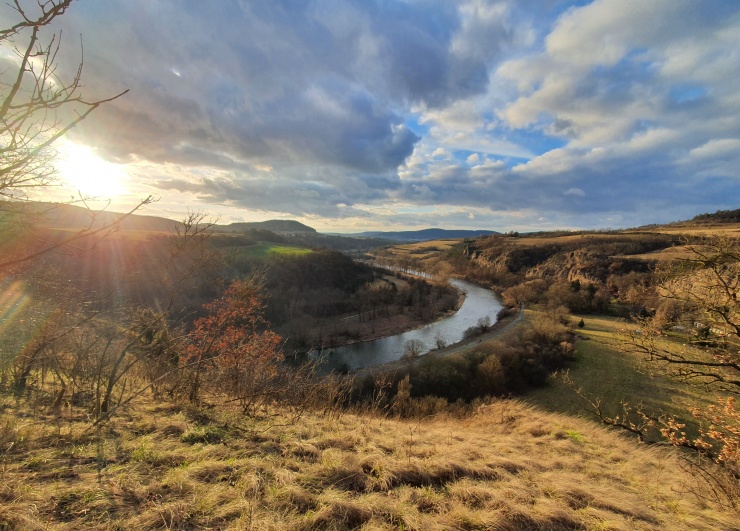
After almost sixteen centuries and two years, the Hostim depot, headed by unique glass cups, is seeing the light of day.
On the afternoon of Friday, February 4, 2022, we received an urgent phone call from Nadi Profantová, PhD, CSc, archaeologist and historian from the ARÚ Prague, specializing in the early Middle Ages, asking for assistance with an unexpectedI had no idea that we would witness the discovery of a quite extraordinary collection from the period of the Migration of Nations.
Already from the description of a chance finder who, while searching for geocaches, noticed shards protrudingemerging from the disturbed terrain, it was clear that this could be a potentially interesting discovery.The Hostim (also Kozel) hillfort in the Beroun-Hostim locality was already known to us from several previous archaeological investigations led by Dr. Profantova, which yielded a number of new and interesting discoveries. After arriving at the site, we climbed the steep slope from the former Alkazar limestone quarry and ascended to the top of the hill where Dr. Profantová and a student volunteer had already begun fieldwork.
After the removal of the larger stone, layer by layer, the uncovering of the soil continued and the first objects began to take shape. The first vessel was consolidated and picked up with a bandage, and it was already obvious at this point that the depot would contain at least one glass vessel. Glass from the Migration of Nations? In Bohemia, in Beroun? No one present could believe their eyes.
Although the work had proceeded with the utmost caution up to this point, it was clear to all of us that there was no room for error. We would have to proceed more slowly and with surgical precision. The rapidly setting sun and the cold creeping in behind our fingernails did not play in our favour. After plotting the basic situation and the first photo documentation, the team collectively came to the conclusion that lighting and packing material would need to be sourced to safely store the finds. My dad and I headed back to the car, and on the way to nearby Beroun, we wondered aloud what all sixteen centuries had been waiting to be uncovered.
Buying the necessary instruments at the local hobby market took more than an hour and we returned to the site almost in the dark, this time through muddy fields in the direction of Hostim. We set up and switch on the spotlights. The glow of the lights hits the ground and reveals the progress that has been made in our absence: the necks of ceramic vessels, the handles of buckets, an iron bell, a large scythe, ...
But the eyes of all were focused above all on a beautiful glass cup of greenish-yellow colour. I thought fleetingly of the museum of ancient glass in Zadar, Croatia, which we had visited years ago. I would never have dreamed that I would see something like this in the country of my birth, let alone that I would be present at the collection of such a unique object.
For the next ten minutes, the atmosphere was so thick it could have been chopped up. The archaeology student, Christopher, proceeded with precision to uncover the cup lying with its neck diagonally in the ground. The rest of us, standing over the by now quite wide and deep pit, watched every movement with bated breath, waiting to see if the cup could be safely removed. After a moment's silence, Dr. Profant said, "Well, you find such a depot about once in a lifetime, and sometimes not at all." Words we all smiled at, but inwardly knew to be true.
In anticipation of the pickup, we readied our phone cameras. Within moments, it was clear over the crackling of roots that the moment we had been waiting for had arrived. The moment felt like time had stopped... Something broke loose from the cup and remained lying in the ground. Did the roots in the ground break the cup into pieces?
No sooner had Christopher raised the cup to a clearly visible level than we were all relieved. It's intact! And to the amazement of all present, there were more glass jars inside! What came loose was not a shard, but the bottom of one of the pizza cups!
Once it was photographed and safely stored in the wooden box, it was time to move on.
This was followed in turn by the removal of a cow bell, a clay jar, a sickle, a bronze and iron handle from the buckets and a roughly metre long scythe in exceptional preservation. Now in the early evening it was decided - the work would be resumed tomorrow, at daylight. Considerably tired and cold, but in good spirits, we set off towards the expedition vehicle after finishing the site. It was time to see our colleagues off to their homes and say goodbye for now.
On the way back to Prague, my dad and I discussed the enormous significance of this discovery and the fact that it had been saved.
On Saturday morning we met at the same place. After reexposing it again, in the daylight we could see more bowl-shaped ceramic vessels, placed next to the crumbling glass cup. Hoops from the buckets, which had been inserted when they were placed, and an iron tool of a tubular shape (otka?) were recovered. Soil samples were taken for leaching and the last glass artefact was removed.
After noon, the director of the Institute of Archaeology, Mgr. Jan Mařík, Ph.D., who checked the progress of the work and helped with the retrieval of the clay mortar. With the help of a detector, a check was carried out to ensure that all metal artefacts had been removed, followed by cleaning of the excavation. The work ceased, the archaeologists took new photographs of the pit and its profile, and after a short walk above the Berounka Canyon we headed home.
Although it might seem that this was just another adventure to "tick off my list", this venture was something special for me... And that is the reason why I am writing these lines. The atmosphere and the genius loci of the Bohemian Karst, so beloved by me, to which our expeditions have been heading since I was born.my childhood, have combined with an absolutely unique and unrepeatable experience that will stay with me for the rest of my life.
With this report I would like to thank everyone without whom this would not have been possible. To the finder, who correctly assessed the situation and thus prevented irreversible damage and destruction of the find. Dr Profant for her promptness and professionalism at the highest level. To Christopher, with whose skill and patience it was possible to safely remove all the artefacts from the ground. To the many specialists and experts outside the field, and to you, the readers, for reaching the end of the story of the Hostim treasure, which after nearly sixteen centuries and two years has seen the light of day.
Double-take
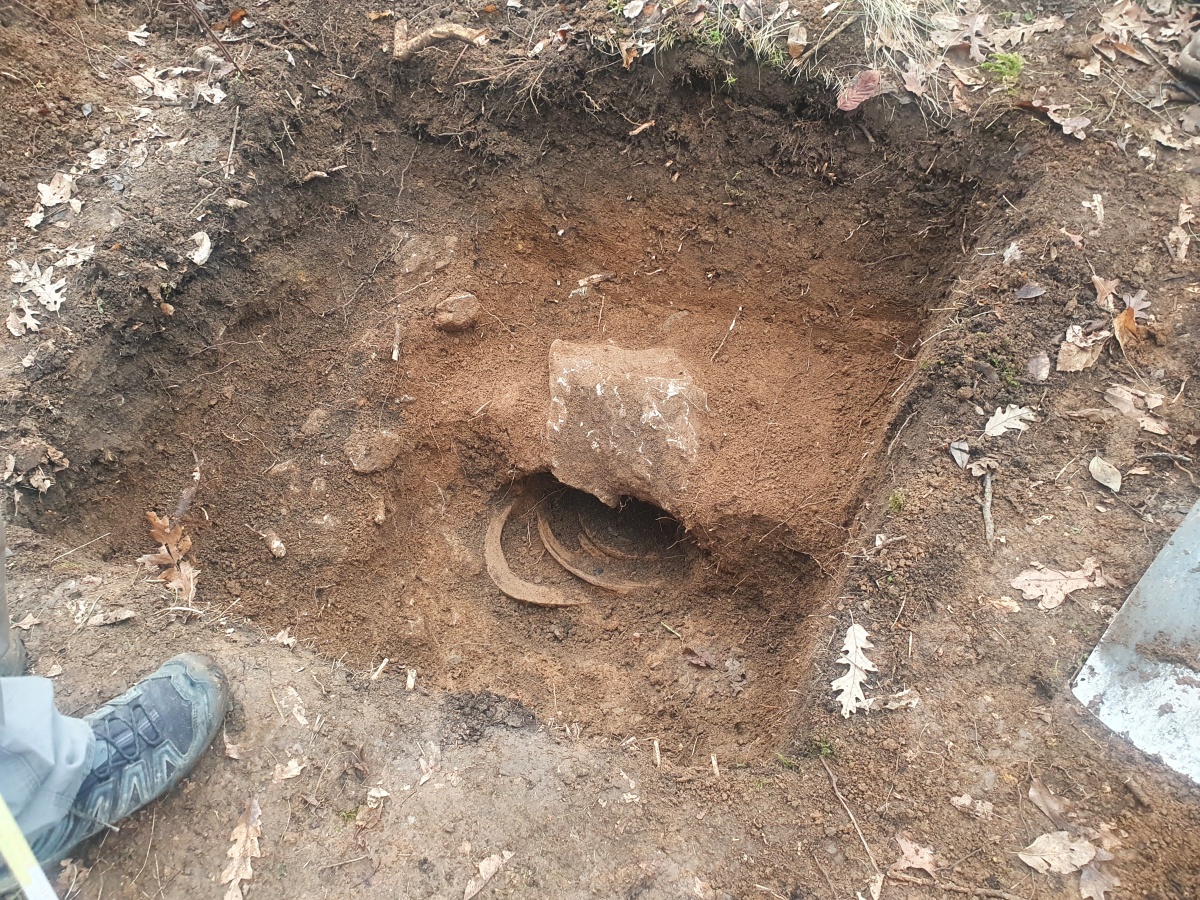 The stone under which the depot was hidden
The stone under which the depot was hidden
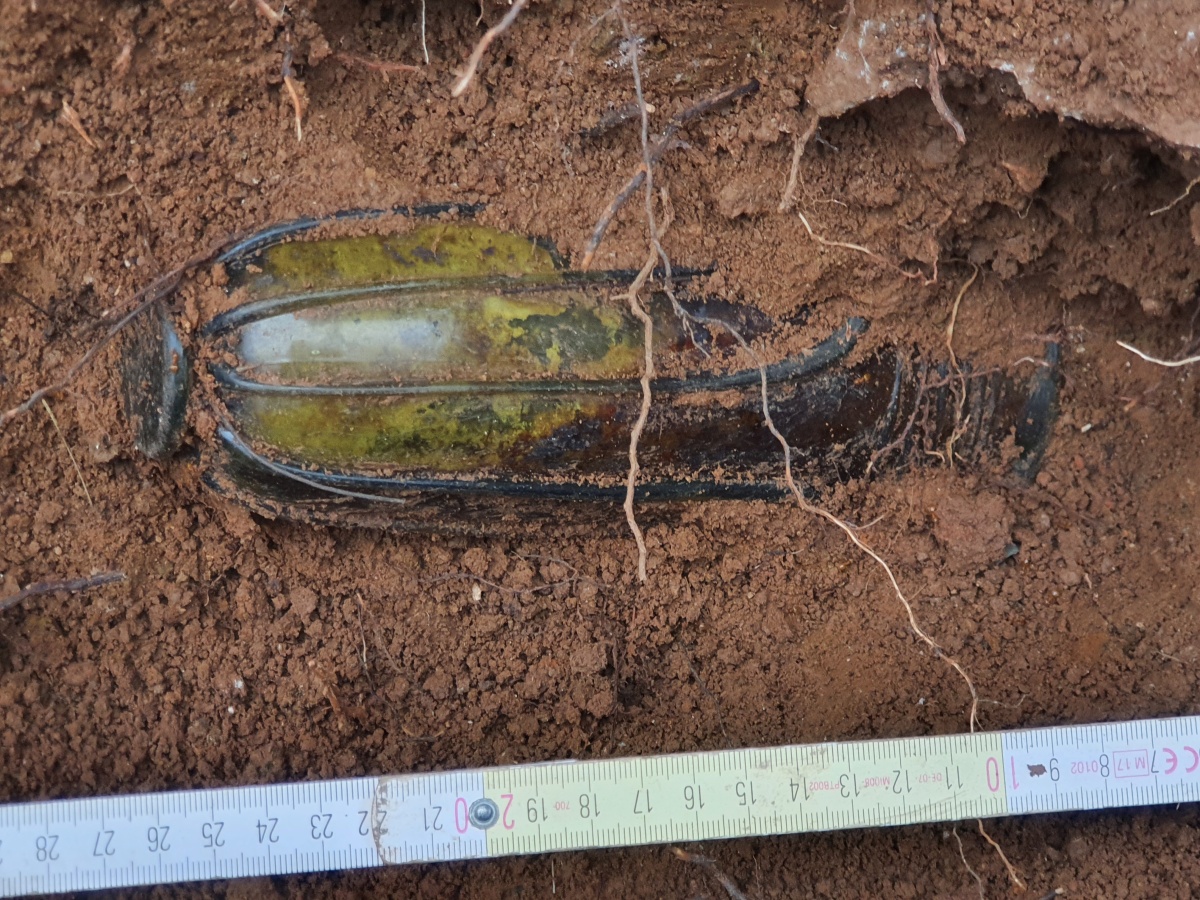 Close-up of the glass cup
Close-up of the glass cup
 Gradual uncovering of the set
Gradual uncovering of the set
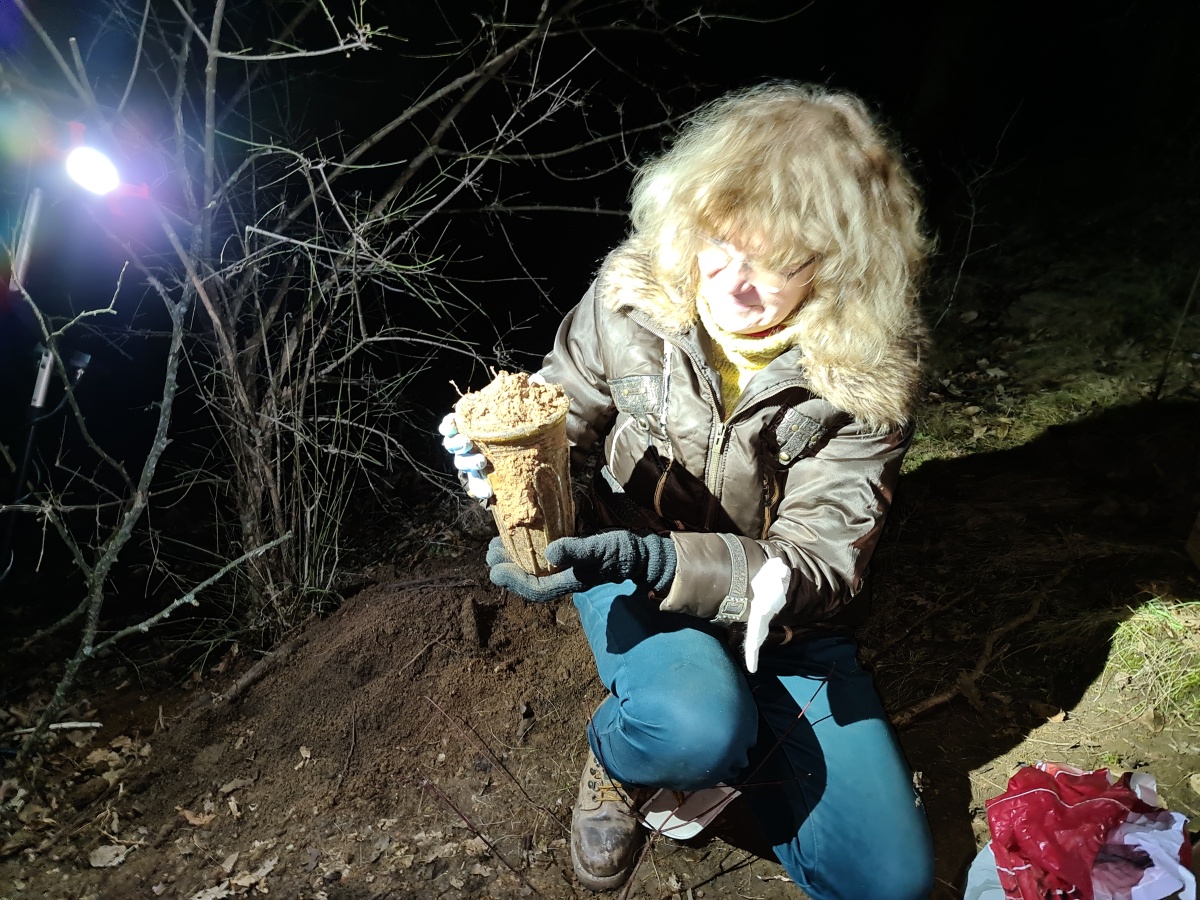 Dr Profant immediately after retrieving the glass
Dr Profant immediately after retrieving the glass
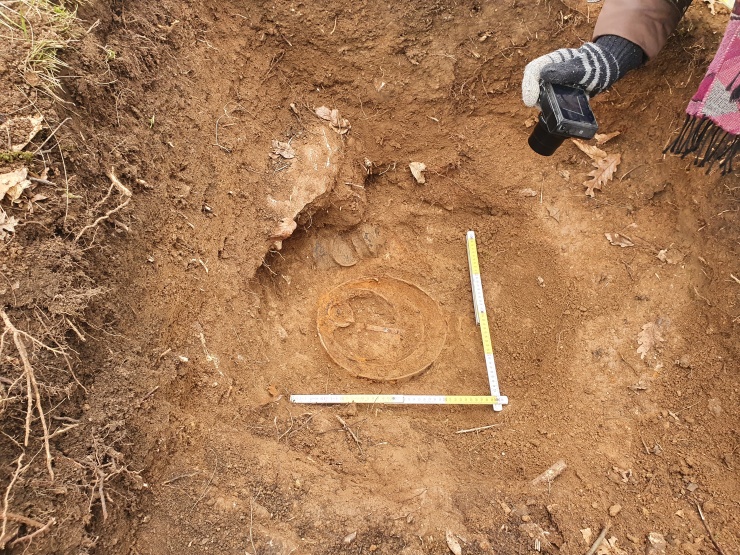 Second day of work
Second day of work
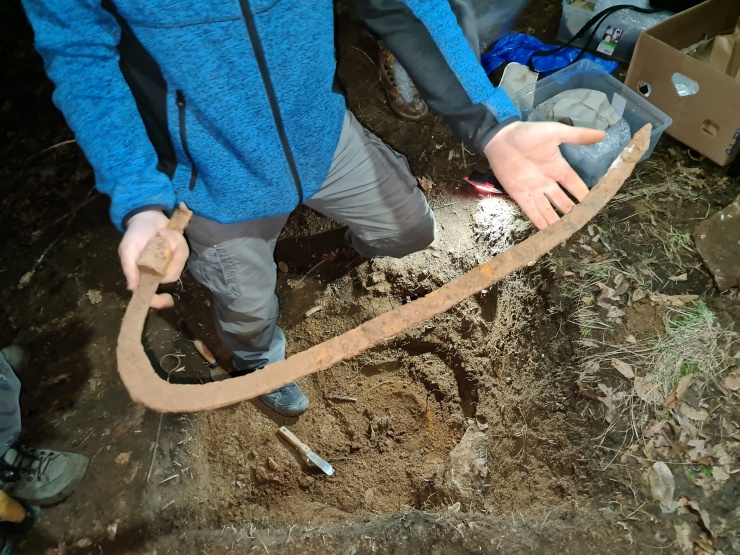 Iron scythe
Iron scythe
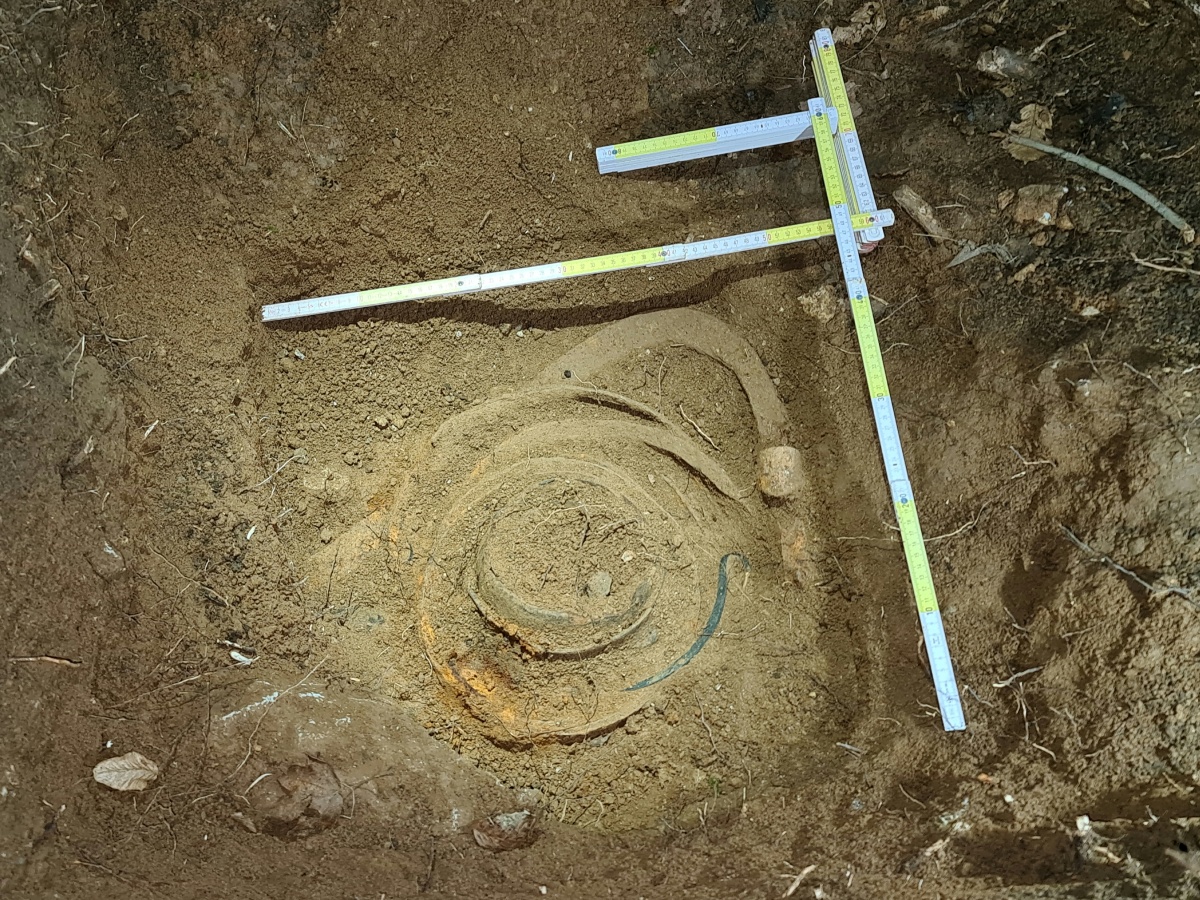 Measurements during the uncovering process
Measurements during the uncovering process
 Clay jars in the depot
Clay jars in the depot
 View from the hillside of the Hostim hillfort
View from the hillside of the Hostim hillfort
The article is included in categories:
- Archive of articles > Treasures
- Archive of articles > Archaeology > Finds and rescue research in the Czech Republic
Post
Pěkný příběh a krásný nález 
Jen doplním, co jsem ještě dohledal: původ skleněných nádob lze hledat jak v ateliérech v římských provinciích, tak patrně i v prvních sklárnách v barbariku, tedy na území barbarů mimo Římskou říši.
Krásné a poutavé čtení 
Moc zajímavý článek o mimořádném pokladu. Ten pohár zdobený těmi skleněnými nitěmi je podle mě typ Snartemo, téměř stejný se našel v roce 1912 v kostrovém hrobě u Tišic. Je to hodně vzácná věc. Původ tohodle typu poháru je snad v Belgii v oblasti města Namur. Po Evropě prý tyhle poháry šířili hlavně Durinkové, kteří je nejspíš i produkovali.
Pohár z Tišic:
https://freeimage.host/i/snartemo.dVoCiv9
Dost se těhle pohárů nachází i ve Skandinávii:
https://www.facebook.com/photo.php?fbid=662012960988015&id=325902217932426&set=a.325963147926333&locale=ms_MY
Durynkové samozřejmě  Zase kule z pravopisu
Zase kule z pravopisu 
Moc hezky napsáno  tady je také jeden článek k nálezu https://ct24.ceskatelevize.cz/clanek/veda/vzacne-artefakty-se-ukryvaly-u-berouna-1500-let-nasel-je-nahodny-kolemjdouci-352054
tady je také jeden článek k nálezu https://ct24.ceskatelevize.cz/clanek/veda/vzacne-artefakty-se-ukryvaly-u-berouna-1500-let-nasel-je-nahodny-kolemjdouci-352054
Pilote, dobře ty :)
Tak to je nádher. Sklo a stěhování národů. Nedávno královské klenoty ze Mšece a Řevničova a nyní další skvost.
U nás na Chrudimsku se také našlo sklo, a tak vás všechny zvu na SN na zámek do Pardubic.
https://www.vcm.cz/navstivte-nas/vystavy-a-expozice/exit-91-vykopavky/
Krásně napsáno, jako bych byl přímo u toho... 👍🙂
... ještě něco bude. Ale více prozrazovat nebudu, je to přeci jenom celé práce Ondry. Ale myslím, že se je ještě na co těšit :)
Moc pěkné  Po tomto vztah nebo souznění s místem ke kterému má člověk určitou vazbu nabere úplně jinou a hlubší "dimenzi". Aspoň já to tak mám🙂
Po tomto vztah nebo souznění s místem ke kterému má člověk určitou vazbu nabere úplně jinou a hlubší "dimenzi". Aspoň já to tak mám🙂
👍 Pěkné počtení a nálezy.
To je fantazie! 

No jo, tam já chodím dole jen na špacír a na pivko k dědkovi do Srbecka 🤷🤦.. 

To Janek67: pořád je potřeba se dívat pod nohy, v čem zrovna šlapeš :)
To je u mě trochu problém, když sem slepej jako patrona. 
Kolem kamenné sekerky sem chodil 2 dny a poznal to, až když sem dohledával v kleče krejcar. 





 🙈🤣🤣🤣
🙈🤣🤣🤣


























